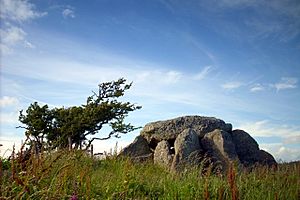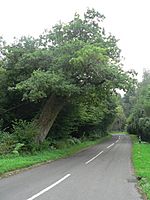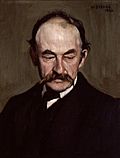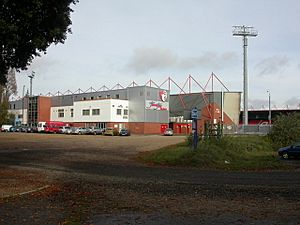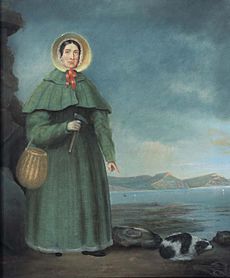Culture of Dorset facts for kids
Dorset is a beautiful county in South West England, right on the coast of the English Channel. It's a medium-sized county, covering about 2,653 square kilometers (that's about 1,024 square miles!). Dorset shares its borders with Devon to the west, Somerset to the north-west, Wiltshire to the north-east, and Hampshire to the east.
About half of the people in Dorset live in the bigger towns like Bournemouth and Poole. The rest of the county is mostly countryside with lots of open spaces. Dorset has a very long and interesting history, with people living here for thousands of years. It has many ancient sites, like the amazing Iron Age hillfort called Maiden Castle.
Dorset is also famous for its writers! It's the home of the famous novelist Thomas Hardy. Another well-known author, Enid Blyton, was also inspired by Dorset's landscapes for many of her adventure books. The people of Dorset even have their own special way of speaking, called a dialect, which you can still hear in some places. They also have unique local foods, like the crunchy Dorset Knob biscuit and tasty Dorset Blue Vinney cheese.
Every year, Dorset hosts many fun events and fairs. One of the biggest is the Great Dorset Steam Fair near Blandford, which is said to be the largest outdoor event of its kind in Europe! There's also The Dorset County Show, which celebrates farming and country life in Dorset.
Contents
Music and Shows
Dorset might be a quiet, rural county, but it still has some great places for music and theatre! Big venues where you can catch concerts and plays include the Lighthouse arts centre in Poole, the BIC and Pavilion Theatre in Bournemouth, and the Pavilion theatre in Weymouth.
One of Dorset's most famous musical groups is the Bournemouth Symphony Orchestra. It started way back in 1893 and is now one of the best orchestras in the whole country! If you love opera, the Dorset Opera Festival puts on a big show every year at Bryanston School. Students perform alongside professional singers and musicians.
There's also a folk music group called The Yetties. They got their name from the Dorset village of Yetminster, where they grew up. Their songs often tell stories about country life and growing up in Dorset. Famous musicians like John Eliot Gardiner, Greg Lake, and Robert Fripp were also born in Dorset.
Dorset's beautiful coastline, countryside, and old manor houses have been used as settings for many films and TV shows. You might have seen adaptations of Thomas Hardy's novels like The Mayor of Casterbridge or Tess of the D'Urbervilles, which were filmed here. The 1980 film The French Lieutenant's Woman, starring Meryl Streep, was filmed in Lyme Regis. The magical movie Nanny McPhee used the Isle of Purbeck as its setting, and From Time to Time with Maggie Smith was filmed at Athelhampton House. Even the 1996 film Emma, starring Gwyneth Paltrow, was filmed at Mapperton House.
Historic Places and Museums
Dorset is packed with history, and you can explore it in over 30 museums across the county! There are museums about all sorts of things, from fashion and design to mining and water supply.
Two really important museums are The Tank Museum at Bovington, which has an amazing collection of tanks, and The Keep Military Museum, which tells the story of the military in the area. The Dorset County Museum in Dorchester, founded in 1846, has huge collections covering the Jurassic Coast, local writers, archaeology, wildlife, and geology.
Dorset has many protected historic sites. There are over 1,500 "Scheduled Ancient Monuments" and more than 12,850 "listed buildings" (buildings that are important and protected). Many of these are old churches, like Christchurch Priory, which is the longest church in England, or tiny ones like St Edwold's.
You can also find nine castles in Dorset! Some, like Corfe, Portland, and Christchurch Castle, were built to defend the land. Others, like Highcliffe and Lulworth, were built to look like castles but were more for show.
Dorset has a very long human history, and you can see it in its ancient sites. There are impressive hill forts like Maiden Castle, Badbury Rings, and Hod Hill. A huge defensive ditch called Bokerley Dyke even helped delay the Saxon conquest of Dorset for over a hundred years!
You can also find many ancient burial sites and standing stones. Some of the most impressive stone circles are at Kingston Russell, Hampton Hill, Rempstone, and Nine Stones near Winterbourne Abbas. Just north of Portesham, there's a giant Neolithic stone structure called the Hell Stone, made of nine upright stones and a huge capstone on top.
Festivals and Fun Events
Dorset is a lively place with lots of annual festivals, fairs, and events!
The Great Dorset Steam Fair near Blandford is a huge outdoor event that celebrates old steam engines and machinery. It's one of the biggest in Europe! The Bournemouth Air Festival is another fantastic event. It's a free air show that attracts over a million visitors who come to watch amazing aerial displays.
The Spirit of the Sea Maritime Festival in Weymouth and Portland celebrates the area's strong connection to the sea with sports, cultural events, and entertainment. The Dorset County Show is a big event that celebrates farming and local produce. It's been going on for over 170 years and attracts around 55,000 people who come to see livestock and local goods.
Besides smaller folk festivals in towns like Christchurch and Wimborne, Dorset also hosts several larger music festivals. These include Camp Bestival, Endorse It (in Dorset), End of the Road, and the Larmer Tree Festival.
Local Culture and Food
The special way of speaking in Dorset, called the Dorset dialect, comes from old Norse and Saxon languages. It was kept alive in isolated areas until railways brought more people and new ways of speaking from London. You can still hear this rural dialect in some villages, and it's preserved in the poems of local writers like William Barnes and Robert Young.
The Dorset Knob is a unique, hard, dry, and savory biscuit from the county. People often eat them with cheese, especially Dorset Blue Vinney. It's said that the famous writer Thomas Hardy loved them! Every year, a fun Dorset Knob throwing competition is held in the village of Cattistock. The festival also includes other silly games like a knob and spoon race and knob darts!
Dorset Blue Vinney is a strong-tasting, crumbly cheese. It's made from unpasteurized skimmed milk. Long ago, the cream was taken out to make butter, which was very popular in London. Since 1986, the village of Marshwood has hosted an annual nettle eating competition, attracting people from all over the world!
Dorset has its own flag, called the Dorset Cross, which was chosen in 2008 after a public competition. It has a white cross with a red border on a golden background. The colors represent Dorset's sandy beaches, famous landmarks like Golden Cap and Gold Hill, and the old Wessex Dragon symbol. The flag is sometimes unofficially called St Wite's Cross, after a Saxon holy woman buried in Whitchurch Canonicorum. Dorset's motto is 'Who's Afear'd', which means 'Who's Afraid?'.
Stories and Legends
Dorset has some interesting old stories and legends. One story is about the Bull Oak, an oak tree near Lytchett Minster with "SC 1849" carved into it. This refers to Samuel Crumpler, who owned the field. In 1849, he walked into the field to prove his bull wasn't dangerous, but sadly, the bull gored him to death.
Another famous tree is the Remedy Oak, just outside Verwood. Legend says that King Edward VI rested there while hunting. People believed that a king could cure the sick just by touching them, so locals gathered around, asking him to touch them, which he did.
A third famous tree was the Monmouth Ash, which stood north of Bournemouth. It was under this tree, hidden in a ditch, that James Scott, 1st Duke of Monmouth was found after he had been on the run following a battle. Some people say the Duke of Monmouth still haunts the road between Uplyme and Yawl, appearing on a white horse!
Art and Literature
Dorset is very famous in English literature because it was the home county of the novelist and poet Thomas Hardy (1840-1928). Many of the places he wrote about in his fictional "Wessex" are actually in Dorset, which he called South Wessex. You can even visit Thomas Hardy's Cottage, where he was born, and Max Gate, his former home in Dorchester, Dorset, both owned by the National Trust.
Many other writers have been inspired by Dorset's beautiful scenery. P. D. James's novel The Black Tower was inspired by Clavell Tower in Kimmeridge. Enid Blyton loved Dorset so much that she moved to the Isle of Purbeck. Many places in her famous books, like Kirrin Castle (Corfe Castle) and Whispering Island (Brownsea), were based on real places in Dorset. Even Studland was the inspiration for Noddy's Toyland!
William Barnes was a poet born in the Blackmore Vale in 1801. He wrote three books of poetry in the Dorset dialect. He loved old Saxon words and even made up new ones if there wasn't a Saxon equivalent! Another poet who wrote in the local dialect was Robert Young.
The novelist John Cowper Powys also had strong connections to Dorset. Several of his novels, including Wolf Solent, Weymouth Sands, and Maiden Castle, are set in Dorset. After he died, his ashes were scattered on Chesil Beach in Weymouth. His younger brother, T. F. Powys, also lived in Dorset, and his village of Chaldon Herring inspired the fictional village of Folly Down in his novel Mr. Weston's Good Wine.
Sports and Fun Activities
Dorset has one professional football club, A.F.C. Bournemouth, who play in the EFL Championship, which is the second-highest league in English football. There are also several semi-professional teams in the county, like Poole Town F.C., Wimborne Town FC, Dorchester Town F.C., and Weymouth F.C..
If you like cricket, the Dorset County Cricket Club plays at Dean Park Cricket Ground in Bournemouth. Rugby Union is also popular, with many clubs across the county.
Dorset is especially famous for its watersports! The calm waters of Weymouth Bay and Portland Harbour, and Poole Bay and Poole Harbour, are perfect for activities like sailing. In fact, Dorset hosted the sailing events for the 2012 Summer Olympics at the Weymouth and Portland National Sailing Academy in Portland Harbour. Many experts say these waters are among the best in Northern Europe for sailing!
Bournemouth also has a large community of surfers. In 2009, an artificial surf reef was built there, one of only four in the world, to create perfect waves.
Famous People from Dorset
Many amazing people have come from Dorset or lived here.
The famous palaeontologist Mary Anning was born and lived in Lyme Regis. She was incredibly talented and discovered the first Ichthyosaur fossil when she was just 12 years old! She also found the first two plesiosaur skeletons. Mary became one of the world's top experts in fossils.
Other notable scientists include Robert Boyle, known for Boyle's law, who lived in Stalbridge Manor. Alfred Russel Wallace, whose ideas about evolution helped inspire Charles Darwin, also lived in Dorset. Tim Berners-Lee, the inventor of the World Wide Web, lived in Corfe Mullen and started his career in Poole.
Many brave explorers and sailors came from Dorset. George Somers from Lyme Regis discovered Bermuda, and Christopher Farwell from Poole was with Sir Humphrey Gilbert when he landed in Newfoundland. Sir Walter Raleigh lived in Sherborne for a time. Verney Lovett Cameron, the first European to cross Africa, was born in Weymouth.
Dorset was also the birthplace of the trade union movement. In 1843, a group of farm workers known as the Tolpuddle Martyrs formed a society to protect their rights.
Today, Dorset is a popular home for many famous people in the performing arts. These include film director Guy Ritchie, actors Martin Clunes and Edward Fox, singer-songwriters Billy Bragg and Noel Gallagher, and TV personalities like Jonathan Ross and Hugh Fearnley-Whittingstall, whose cooking shows are filmed at his home near Bridport.
Many writers have also chosen Dorset as their home, including Douglas Adams (who wrote The Hitchhiker's Guide to the Galaxy), Ian Fleming (creator of James Bond), and John le Carré (famous for spy novels). The artist Sir James Thornhill and photographer Jane Bown were also born in Dorset.
|


